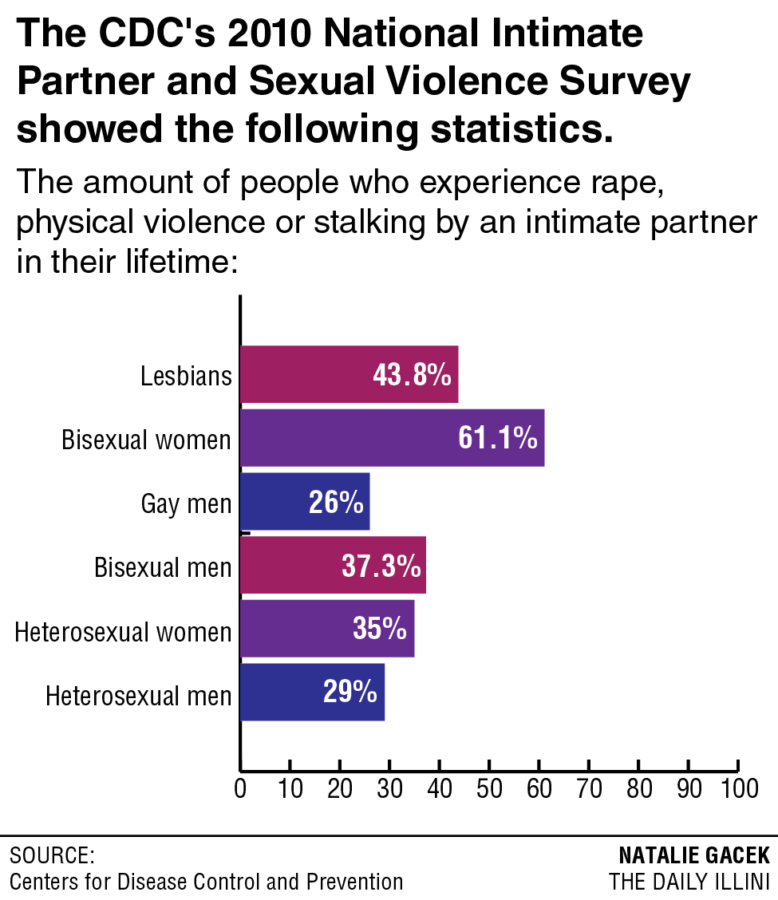Broaden your understanding of abuse
October 28, 2015
When we think of domestic abuse, we typically think of a man hitting a woman. This assumes domestic abuse happens within, and only within, heteronormative relationships. It further takes for granted the abuse is physical rather than emotional, sexual, financial, etc.
The reality is that domestic abuse can happen to absolutely anyone in a variety of forms. It’s very strange that we tend to think otherwise.
On Monday night, in accordance with Domestic Violence Awareness Month, the Women’s Resource Center held a dialogue to discuss the prevalence of domestic abuse within same-sex relationships.
The panelists made clear not only is domestic abuse an issue in many non-heteronormative relationships, but identifying as gay, lesbian, bisexual or transgender can lead to increased difficulty in dealing with abuse as a result of double oppression.
For instance, panelists discussed the fact that non-heteronormative relationships are often stereotyped as being sexually deviant. Admitting there is abuse within a same-sex relationship is often —incorrectly — taken as evidence to support that stereotype.
Get The Daily Illini in your inbox!
Many victims of domestic abuse who are not biologically regarded as female can struggle to find domestic abuse shelters and emotional support due to unfortunate stigmas against male domestic abuse victims. People, upon hearing that a man is the victim of domestic abuse, oftentimes then characterize the man as non-masculine.
But these are issues cannot even be effectively discussed until we broaden our mental framework for domestic abuse to include same-sex relationships. We have to extend our understanding of abuse until it becomes accurate.
These narrow boxes in which we theorize socially harmful phenomenon and their victims unfortunately extend far beyond domestic abuse.
When we think of anorexia and bulimia, we generally assume that the victim must be a young, white woman. When we think of both self-harm and sexual assault, we tend to conclude these are only female issues.
But again, this doesn’t reflect reality. Men make up 10 to 15 percent http://www.anad.org/get-information/about-eating-disorders/eating-disorders-statistics/JT of people struggling with anorexia or bulimia. Multiple studies suggest self-harming is just as common in men as in women. http://www.jabfm.org/content/23/2/240.fullJT
These assumptions may or may not be accurate in regard to what identity group is most commonly affected by a given social issue.
Abuse, anorexia, bulimia, self-harm, etc., can happen to anyone, regardless of sexual orientation, gender identification, or any other social categorization. To believe otherwise is not only misinformed, but also potentially dangerous.
When we prescribe certain social issues can only affect one group, it can potentially blind us when these social issues do affect members of a group we hadn’t expected. If we expect these issues to only produce certain signals, such as expecting to see a bruise when confirming domestic abuse, we may, as a result, remain ignorant when it happens in different ways.
We may miss or ignore the signs of unhealthy behavior in those around us or in ourselves.
Men, for instance, are much less likely to seek help for anorexia or bulimia because it is thought of as a “woman’s disease.” We, as a society, need to open our minds wider.
To engage with these baseless notions can also mean reinforcing stereotypes. It’s possible we tend to think of domestic abuse as a man hitting a woman, in part, because we “know” that men are assumed to be strong, and women are assumed to be weak.
These assumptions also lead toward the slippery slope of victim blaming in which we believe that there is a reason behind why someone is a victim of abuse or a disease like anorexia, bulimia, or self-harm. It’s then only a small step toward believing a victim must have done something to deserve abuse or disease.
To be sure, it is absolutely imperative we consider intersectionality when analyzing the effects of a social issue to determine whether there is double, triple, quadruple, etc., oppression occurring so we can best assist victims. It’s important we recognize these issues do affect some social groups more than others so we can engage in dialogue about what societal undercurrents cause that behavior.
But it is equally important we never assume diseases or abuse can only affect certain identities. We must, therefore, reframe the manner in which we understand these issues to ensure we offer support to all victims of any sort of socially harmful practice.
Alex is a senior in LAS.







